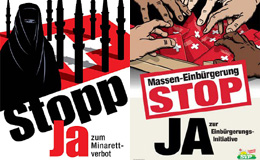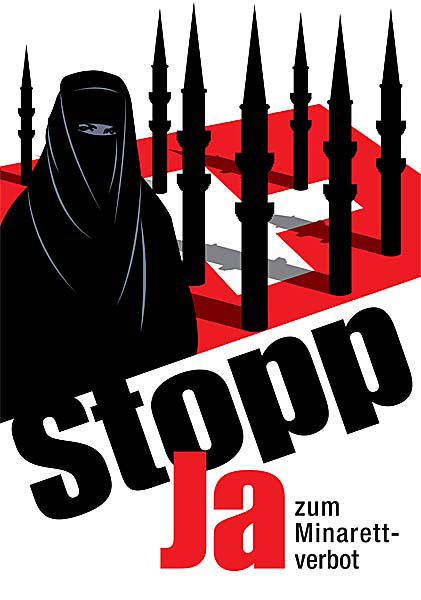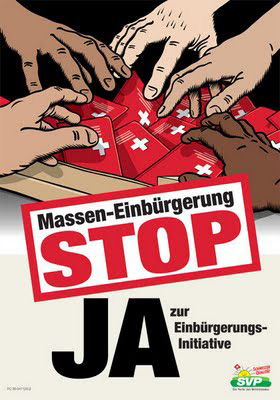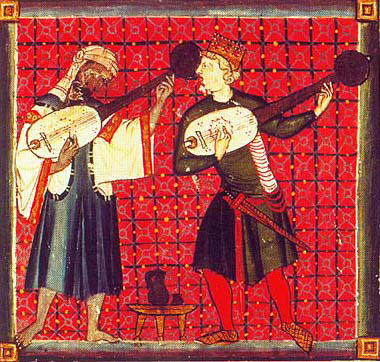COLUMNS
360º Architecture

28 January, 2010
Europe’s Civilization under Threat
The current global economic crisis is used across Western Europe to feed a growing intolerance towards immigrants, in general, and a hysterical Muslim Scare, in particular. 
On 29 November 2009, 57.5 percent of the Swiss population ratified a referendum that forbids the construction of minarets attached to mosques. In the latest issue of the Architectural Review, Layla Dawson observed that the new Paragraph 3 to Article 72 of the Swiss constitution will come to replace an older Paragraph 3, from the 1874 constitution, which subjected potentially reactionary Roman Catholic dioceses to federal approval, and was only deleted in 2000, thus substituting 'one discrimination for another'.(1) The United Nations High Commissioner for Human Rights, Navanethem (Navi) Pillay, said the referendum was the product of 'anti-foreigner scare-mongering'. Switzerland has an estimated 150 Muslim cultural and prayer centres, serving the country's Muslim population of 320,000, proportionately the third largest in Western Europe. There are only four minarets in Switzerland and the call to prayer is banned. The inflammatory populist rhetoric of Christian fundamentalists and right-wing nationalists who promoted the ban on minarets appealed to popular fears, through a campaign poster that showed the Swiss flag colonized by black minarets launching like missiles, and the portrait of a woman wearing a black niqāb (a full-face veil leaving only the eyes visible). Switzerland's new constitutional amendment 'denies Muslims the freedom to manifest their religion in public...guaranteed by international human rights treaties, such as the International Covenant on Civil and Political Rights (ICCPR) and the European Convention on Human Rights, both of which Switzerland has ratified'. The UN High Commissioner for Human Rights and the UN expert on religious freedom have condemned the vote as discriminatory and a violation of human rights.(2) On the same day, a second referendum that sought to oppose exports of military weapons and war materiel was overwhelmingly defeated by 68.2 percent of voters.

Τhe poster of the Swiss campaign for a ban on the construction of minarets
In the wake of the referendum outlawing the construction of minarets, the right-wing Swiss People's Party (SVP in German, UDC in French and Italian), which claimed that minarets are 'symbols of political-religious imperialism', promoting 'the Islamization of Switzerland,' proposed a new referendum for the deportation of all immigrants who committed a crime, an expulsion law that by definition could apply only to immigrants and non-naturalised residents, including refugees and minors or their parents. In 2008, the SVP had used another blatantly racist poster showing dark hands reaching for Swiss passports, to lead a campaign to re-introduce secret ballots allowing a town or commune to vote on citizenship applications.(3) The practice was common in some German-speaking areas of Switzerland until Parliament passed a law in December 2007 banning it, after it became clear that some towns were regularly rejecting candidates from the Balkans, Turkey and Africa, while approving those from Western Europe. In the referendum of 1 June 2008, voters in Switzerland rejected the move to make it ever harder for foreigners to obtain citizenship. Over 20% of Switzerland's population is foreign. Most have been in the country for many years, and around a third of them were born in Switzerland. A September 2000 referendum had defeated the sixth initiative since 1970 to halt immigration, by a clear majority of 63.7 percent.

The poster of the SVP campaign to re-introduce secret ballots
allowing a town or commune to vote on citizenship applications
Ahead of general elections, in 2007, the SVP was again calling for the deportation of all immigrants who committed a crime in Switzerland, with an outrageous campaign image of white sheep kicking a black sheep off the Swiss flag. On 31 August 2007, the Guardian reported that Switzerland's largest political party was condemned for the 'oppressive deportation scheme that allegedly mirrors a law operated by Nazi Germany'. (4) Hundreds of the black-sheep posters around the country were defaced, while Swiss President Micheline Calmy-Rey denounced the poster as racist and disgusting. Another provocative SVP poster caused outrage. It showed veiled Muslim women accompanied by the question 'Where are we living, Baden or Baghdad?' Following a court ruling, the SVP was ordered to withdraw a campaign video showing what it claimed were young hooded foreigners committing violent crimes, after seven Swiss youngsters who actually took part complained they had been told they were taking part in a crime-prevention video. (5) Footage juxtaposed the staged scenes of supposedly violent foreigners with tourist-postcard scenes of Switzerland, and featured the message: 'Heaven and Hell'.

The poster of the SVP campaign for the deportation of all immigrants
who committed a crime in Switzerland
The latest xenophobic campaign against minarets was more canny than the previous ones, and, sadly, more effective. It exploited architecture and the sacrosanct image of the supposedly traditional European city, which it presented under siege and terrorized, to attract media attention, manipulate and polarize public opinion, 'manufacture consent', to use Noam Chomsky's term, stir up prejudices against Muslims presented as enemies, demonize foreigners and segregate the population, galvanize far-right parties and spread fear across Europe. The use of the trope of war and the representation of minarets as weapons ready to attack was clearly intended to create citizenships of fear, fuel a dispute over space, and incite a popular reaction. Significantly, the Dutch right-wing extremist Geert Wilders, chairman of the Freedom Party (PVV), the Italian government minister, Roberto Calderoli, of the xenophobic Northern League, Marine Le Pen, daughter of Jean-Marie Le Pen and vice chairman of the France's extreme right-wing National Front, the Danish People's Party, Vlaams Belang in Belgium, and Austria's two main extreme-right parties, the Freedom Party of Austria and the Alliance for the Future of Austria, welcomed the Swiss discriminatory decision to ban minarets, and pledged to pursue similar measures in their countries. Other European and US voices also expressed support for the result of the Swiss referendum. The Wall Street Journal lamented the fact that the decision means 'the building of mosques is unaffected, and the vote does not affect the four existing minarets in the country'. It called it a mere 'symbolic gesture, [which] seems to encourage a head-in-the-sand approach toward the 5% of Swiss who are Muslim. In much of Europe, this is the norm anyway, the result of political correctness and cowardice'.(6)
The current global economic crisis is used across Western Europe to feed a growing intolerance towards immigrants, in general, and a hysterical Muslim Scare, in particular. In France too, marginalization techniques have exploited emotive issues: the wearing of the veil and what Sylvain Gouguenheim sought to attack in his 2008 book, Aristotle au Mont Saint-Michel: the 'Islamization' of Western cultural heritage, which, he implies, is the intention of 'modern research (especially French research), which emphasizes that medieval culture is not just the heritage of the Classical Latin and Greek tradition, together with the Judaism of the Bible, but also of the Arabic tradition'.(7) His book is a reaction to a 'scandalous' thesis, Gouguenheim says, which he wants to prove false. In his preface, he writes: 'the dark days (les âges sombres) of the Middle Ages have returned. The cultural history of Europe, however much it has been illuminated for several decades by the work of numerous medievalists, is becoming the object of revision. It is now replaced by the biased image of a Christianity which lags behind an "Islam of Enlightenment" (un «Islam des Lumières») to which it owed its rise, thanks to transmission of Greek learning of which the Middle Ages had lost the keys. One speaks of a "forgotten heritage" which the Europeans had to be made aware of.'(8) A professor of medieval history at l'École Normale Supérieure de Lyon, Gouguenheim refers specifically to a report of 8 November 2002, by the European Commission of Culture, Science and Education, 'which proposed to amend school textbooks with a view to recording the position of Islam in the European heritage'.(9)
As Charles Burnett noted, in his excellent and comprehensive review of Gouguenheim's book, the purpose of that report 'was to promote understanding between the countries north and south of the Mediterranean in a comprehensive way, including, on the educational side'. Among other things, it proposed 'co-operating to eliminate reciprocal stereotypes, prejudices and untruths from the different education systems by jointly revising school textbooks, particularly history books'.(10) Gouguenheim's thesis that the European culture owes nothing to Arabic culture, but descends directly from Greece, is undermined, not only by the book's many, well documented factual errors and omissions (most crucially, as Burnett underlines, 'there is absolutely no evidence that James of Venice [the book's main hero] himself was at Mont-St-Michel'), but, most importantly, by the fact that the book's myopic focus on few philosophical texts as fully representative of the whole of European culture relies on a narrow definition of philosophy, and, even more seriously, assumes a definition of culture that entirely excludes science and technology, literature, art, architecture and a lot more.
Burnett comments: 'The preeminence of Arabic sources for Western [mediaeval] philosophy can be seen in the fact that, when Giles of Rome criticizes the errors of the philosophers in ca. 1270, all the philosophers named are Arabic or wrote their philosophy in Arabic (e.g. Maimonides), with the exception of Aristotle himself.' The mediaeval philosophers looked for knowledge wherever available, independent of religion: 'Maimonides and Averroes were cited in philosophical texts without regard to the fact that the one was a Jew, the other a Muslim.' Burnett also goes on to say that 'In the field of science and technology the transmission of information and techniques from the Islamic world to Western Europe has been uncontroversial. It is plain to see that Arabic numerals have been adopted by European mathematicians, that techniques for building bridges, for raising water and making paper were introduced into Europe from the Islamic world'.(11) He lists a number of studies that have documented the case. As far as the arts are concerned, it suffices to look at Islamic and post-Islamic Spain and its colonies, to marvel at the astonishing quality of the artworks that resulted from the long periods of fertile coexistence and cultural interaction between mediaeval Spain's peoples of three different faiths. The great mosques of Moorish Spain drew inspiration from the monuments of Syria as well as from Roman buildings, and Christian churches on the wake of the Iberian reconquest bore a marked Moorish imprint. As J. H. Elliott notes, 'Fifteenth-century Castilian court life was permeated by Moorish tastes and customs, and when Ferdinand and Isabella accepted the surrender of Granada they did so wearing Moorish dress'.(12) In the first paragraph of his preface, Gouguenheim refers with vexation to María Rosa Menocal's book The Arabic Role in Medieval Literary History: A Forgotten Heritage (Philadelphia: University of Pennsylvania Press, 1987). Menocal has also published The Ornament of the World: How Muslims, Jews, and Christians Created a Culture of Tolerance in Medieval Spain (Boston and New York: Little, Brown & Co 2002), and, more recently, with Jerrilynn D. Dodds, The Arts of Intimacy: Christians, Jews and Muslims in the Making of Castilian Culture (New Haven and London: Yale University Press, 2009). The latter focuses on the art, architecture and poetry produced in the mediaeval Iberian peninsula. This impressive study documents the formation of Castilian culture out of the interaction and the sharing of 'a common space' with Islam and Judaism.

Moorish and Christian musicians from the Cantigas de Santa Maria,
manuscripts written during the reign of Alfonso X El Sabio (1221-1284)
In case one needed an example of Islam's contribution to Europe's everyday life and culture, we needn't look further than at that most loved and ubiquitous space of the European city, an institution that has played a major role in its social, cultural, commercial and political life, from the seventeenth century onwards, the coffeehouse: a direct import from the Muslim world. Pasqua Rosee (1651-1656), keeper of the first coffeehouse in London, probably opened in 1652, is a typical example of an entrepreneur who flourished in an environment receptive to foreigner influences, customs and tastes, and a world where human mobility was, as it always has been, a source of cultural enrichment. Rosee was probably born into the ethnic Greek community in Ragusa, Sicily, and later lived in Smyrna, in the Ottoman empire. In 1651, he moved to London in the service of Daniel Edwards, an English Levant merchant, whom Rosee met in Smyrna, and who helped him to establish his business selling coffee to the public from a shed in the churchyard, in the parish of St Michael Cornhill. The first coffeehouse in England was probably established in Oxford a few years earlier, in 1650, by a Jewish entrepreneur named Jacob.(13) The ban on minarets is as irrational as a ban on coffeehouses would be.

Cafe Gerbeaud, Budapest, photograph by Styliane Philippou
Recent events across Europe give us reason to worry as we witness a popular attitude of growing racial and religious intolerance, and even a worrisome number of acts of violence and grotesque vandalism. Spikes topped with pigs' heads were planted on the site of a planned mosque in Austria on New Year's Eve 2007. In 2008, in the Italian city of Padua, Leandro Comacchio, a town councillor for the Northern League, strolled a pig on a site earmarked for a mosque in order to desecrate the ground for Muslims. Another Northern League councillor, Mariella Mazzetto, had done the same one year earlier, and later claimed that there was nothing racist in that. In March 2009, a pig's head without eyes was placed on the fence of the mosque in Prague's Kyje district, with a sign that read: 'Stop Islam'. During the campaign against minarets in Switzerland, Geneva's mosque was vandalized. In Greece, the Jewish cemetery of Ioannina was repeatedly vandalized in 2009, and recently the Etz Hayyim Synagogue in Chania, Crete, a mediaeval historic monument painstakingly restored in 1999, suffered two devastating arson attacks, on 5 and, inexcusably, again on 16 January. The tragic destruction of Jewish cultural heritage in Greece affects the national and the international community as a whole, and Greece's failure to prevent especially the second attack contravenes the UNESCO Declaration concerning the International Destruction of Cultural Heritage, which proclaims that 'States should take all appropriate measures to prevent, avoid, stop and suppress acts of intentional destruction of cultural heritage, wherever such heritage is located'. (14) It is up to the Greek government and Greek citizens to ensure that the recent government legislative proposal that will grant citizenship to second-generation immigrants, finally addressing the country's absurd immigration policies, long condemned by international organisations, will not be used by nationalist populist rhetoric to incite irrational acts of aggression against foreigners and against the country's cultural heritage.
Demagogic rhetoric is used across Europe these days to inflame passions, marginalize and inspire the rejection of the Other in a manner that reminds us of the days of the crusades, jihad, Inquisition and pogroms. Recent laws in a number of German states prohibit teachers and other civil servants from wearing the headscarf at work, claiming that they intend to protect women's rights and promote the integration of Muslim women in German society. But, as Human Rights Watch remarks, 'general bans are a blunt instrument likely to do more harm than good. They stigmatize and marginalize women who choose to wear the veil and violate their fundamental rights, while doing nothing to help those who wear the veil under coercion'.(15) The intention to discriminate against Muslim women is evident by the fact that the same law does not apply to the Christian nuns who teach at German state schools.
Two weeks ago, the parliamentary leader of the ruling French party, Jean-François Copé, presented a new law which will impose fines of up to €750 on anyone appearing in public 'with their face entirely masked', a measure directly targeted at beveiled Muslim women. He spoke of 'a problem of respect towards women and of security. We measure the modernity of a society in terms of how women are considered and respected,' he added,(16) addressing a French society that, unlike the rest of Europe and regardless of EU guidelines, continues to customarily discriminate against women, by insisting on the use of the appellations Madame and Mademoiselle, according to marital status, both in everyday life and in official administrative documents. On 27 June 2008, the French Conceil d'état confirmed a government decision to deny French citizenship to a Moroccan woman, wife of a French citizen and mother of four French citizens, on the grounds that, although she fulfilled the conditions of nationality, her decision to wear the full veil is 'a radical practice of her religion incompatible with the essential values of the French community and notably with the principle of the equality between the sexes'. Although the decision enjoyed general approval in France, Danièle Lochak, a professor of law at the Université de Paris X, observed that 'if you follow this logic to its logical conclusion, it means that women whose partners beat them are not worthy of being French'. Robert O. Paxton felt tempted 'to imagine the judges of 2008 applying, anachronistically, their criterion of marital subjection to all French women married before 1965, the date when married women were first permitted to open a bank account of their own without their husband's written permission'.(17) Indeed, there would not be many French women left if one applied the criterion to all the French women who opt to use their husband's name, despite the fact that no official due process formalizes this usage. The French law (loi du 6 fructidor de l'an II de la République) stipulates that 'no one may use any other name or surname than those given on their birth certificate'. Yet, unless women complain vigorously and insist on their lawful rights, French administration services, banks etc. customarily replace women's names with those of their spouses in official documents, and apply intimidation tactics to persuade foreign women that 'this is how it is done in France'. The Swiss initiative against minarets, which used the image of a fully-veiled woman to scare and attract the votes of feminists, was supported by 70 percent of the population of Appenzell Innerroden, the canton that did not grant women the right to vote until 1990.
Jewish groups and media criticized the scare tactics of the Swiss campaign against minarets, which 'recalled centuries of restrictions on the size or prominence of synagogues. The Swiss ban,' Ruth Ellen Gruber said, 'is just the latest example of how governmental authorities target religious architecture as a means of limiting religious or cultural expression'. Samuel Gruber, president of the International Survey of Jewish Monuments, pointed to a lesson from history: 'Beginning in the fourth century and continuing through the Middle Ages, and again in the 20th century, the "legal" restriction and destruction of synagogues quickly led to the same policies applied against individuals, and then whole communities.'(18) Both the Hague and Geneva Conventions consider the destruction of cultural heritage a war crime. In 2003, at its thirty-second session in Paris, UNESCO unanimously adopted the Declaration concerning the International Destruction of Cultural Heritage, mainly in response to 'the tragic destruction of the Buddhas of Bamiyan [in Afghanistan in 2001] that affected the international community as a whole...expressing serious concern about the growing number of acts of intentional destruction of cultural heritage'.(19) The anti-minaret propaganda's images did not only allude to terrorism, which they insultingly associated with all Muslims; they also depict a country at war. And as Ruth Ellen Gruber reminds us, 'the deliberate destruction of architectural heritage' has often been used 'as a tool of conflict or persecution,' including in the Europe of the 1990s.(20) In his book The Destruction of Memory: Architecture at War (London: Reaktion Books, 2006), Robert Bevan has argued that it is part of the 'cultural cleansing' and 'cultural genocide' that accompanies war and a way to establish hegemony by removing the physical traces of a thus visibly defeated community. Quoting again Samuel Gruber, Ruth Ellen Gruber reveals the real nature of Switzerland's attack on Islamic architecture: 'Restricting specific types of religious or cultural expression - especially when such restrictions are deliberate exceptions to existing building, zoning, health and safety codes - is discriminatory. [It is] an act of denigration of cultural custom and, by extension, of the people who cherish, or the religion that requires, those very customs.'(21) The UNESCO Declaration concerning the International Destruction of Cultural Heritage recognized 'the importance of the protection of cultural heritage and reaffirm[ed] its commitment to fight against its intentional destruction in any form so that such cultural heritage may be transmitted to the succeeding generations'. The intentional destruction of the traditional typology of a religious building unjustifiably prevents the transmission of cultural heritage to the succeeding generations.
Gouguenheim's lamentable attempt to prove Europe's cultural purity, misrepresenting its cultural heritage in the process, Switzerland's decision to protect its architectural purity, and other recent measures to safeguard Europe's sartorial or other presumed purity are supposedly advanced as means to avoid the risk of the kind of social tension and confrontation that has often and until recently surfaced in European multiethnic and multifaith societies. But, apart from the fact that such claims of cultural purity sound frighteningly close to claims of racial purity and their consequences, which we ought not forget, they should also be recognized as acts that pose a threat to Europe's cultural heritage, the result of multiple influences and confluences. The proliferation of such acts would cause an undesirable impoverishment and stagnation for European civilization as we know it, created through continuous enrichment, development, supplement and mixture.
Notes
1 Dawson, Leyla, 2010, 'The Swiss Referendum in Favour of Banning Minarets Is an Expression of a Paranoid Fear of the "Other"', Architectural Review, vol. 227, no. 1355 (January), p. 31.
2 See Human Rights Watch, http://www.hrw.org/en/news/2009/12/04/switzerland-minaret-ban-violates-rights
3 The image had been used successfully in 2004 in a campaign for tighter immigration laws.
4 http://www.guardian.co.uk/world/2007/aug/31/thefarright
5 http://news.bbc.co.uk/2/hi/europe/6980766.stm
6 'Switzerland and the Minaret', 2009, Wall Street Journal, http://online.wsj.com/article/SB10001424052748703939404574565674154159110.html
7 Burnett, Charles, 2008, 'Mont Saint-Michel or Toledo: Greek or Arabic Sources for Medieval European Culture?', http://www.muslimheritage.com/topics/default.cfm?ArticleID=1083. This excellent review of the book was delivered as a lecture at Dumbarton Oaks, Washington DC, on 23 October 2008.
8 Gouguenheim, Sylvain, 2008, Aristotle au Mont Saint-Michel : Les racines grecques de l'Europe chrétienne (Paris: Éditions du Seuil), p. 9. The translation is from Burnett.
9 Gouguenheim, pp. 14-15, note in p. 218. See p. 164: 'En somme, au Moyen Âge l'Islam ne s'est pas hellénisé, pas plus que l'Occident ne s'est islamisé'. Sure, the West did not adopt the religion of Islam; but neither did it adopt the religion of Aristotle.
10 Burnett
11 Burnett
12 Elliott, J. H., 2009, 'A Question of Coexistence', The New York Review of Books, 13 August, p. 42. This article reviews two books: Jerrilynn D. Dodds and María Rosa Menocal's, The Arts of Intimacy: Christians, Jews and Muslims in the Making of Castilian Culture (New Haven and London: Yale University Press, 2009), and Stuart B. Schwartz's All Can Be Saved: Religious Tolerance and Salvation in the Iberian Atlantic World (New Haven and London: Yale University Press, 2009).
13 Oxford Dictionary of National Biography, http://www.oxforddnb.com/public/dnb/92862.html
14 'UNESCO Declaration concerning the International Destruction of Cultural Heritage', 2003, 17 October, http://portal.unesco.org/en/ev.php-URL_ID=17718&URL_DO=DO_TOPIC&URL_SECTION=201.html
15 Sunderland, Judith, 2009, 'The Minaret Vote, Europe's Call to Show Bias', Human Rights Watch, 2 December, http://www.hrw.org/en/news/2009/12/02/minaret-vote-europes-call-show-bias
16 Copé, Jean François, 2009, 'Copé : «Pourquoi il faut une loi anti-burqa !»', Le Figaro Magazine, 8 January, http://www.lefigaro.fr/politique/2010/01/09/01002-20100109ARTFIG00050--pourq-u-oi-il-faut-une-loi-anti-burqa-.php
17 Paxton, Robert O., 2009, 'Can You Really Become French?', The New York Review of Books, 9 April, p. 53.
18 Gruber, Ruth Ellen, 2010, 'Swiss Minaret Ban Recalls Synagogue Bans of Past Eras', The Global News Service of the Jewish People, 14 December, http://jta.org/news/article/2009/12/14/1009716/swiss-minaret-ban-recalls-synagogue-bans-of-past-eras
19 'UNESCO Declaration concerning the International Destruction of Cultural Heritage'
20 Gruber, Ruth Ellen
21 Gruber, Ruth Ellen
Related articles:
- 360 Degrees Architecture ( 10 October, 2009 )
- Τhe Roots of the Industry of the Image ( 27 October, 2009 )
- Anish Kapoor: Non-objective Objects ( 26 November, 2009 )
- Love Thy Planet ( 28 December, 2009 )
- Made of Stone and Water, for the Human Body ( 28 February, 2010 )
- Bokja: ‘A Woman’s Affair’ ( 28 March, 2010 )
- Brasília from the Beginning, Fifty Years Ago ( 07 April, 2010 )
- Brasília, ‘capital of the highways and skyways’ ( 30 April, 2010 )
- Oscar Niemeyer’s Permanent International Fair in Tripoli ( 29 May, 2010 )
- Learning from Miami ( 10 July, 2010 )
- The Greatest Show on the Beach ( 08 August, 2010 )
- Oscar Niemeyer: Curves of Irreverence ( 28 March, 2011 )
- The Lizards of Djenné ( 26 September, 2010 )
- Transformed by Couture ( 29 October, 2010 )
- Another Athens Is Possible ( 02 December, 2010 )
- From Juan O’Gorman for Diego Rivera and Frida Kahlo ( 28 February, 2011 )
- Roberto Burle Marx: The Marvellous Art of Landscape Design ( 27 May, 2011 )
- The Danger that Lurks on this Side of the Gates ( 10 September, 2011 )
- Eduardo Souto de Moura ( 21 November, 2011 )










